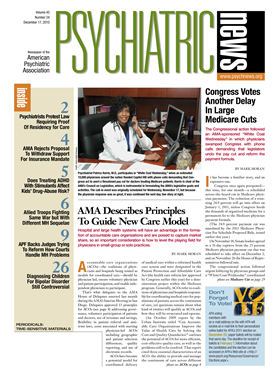Many of our members have told me that they have little understanding of APA's governance structure through which the Association carries out its work to meet its missions: to promote the highest quality care for individuals with mental illness and substance use disorders and their families, promote psychiatric education and research, advance and represent the profession of psychiatry, and serve the professional needs of its membership.
If you find your eyes glazing over as you read this and your finger itching to turn the page, please resist the urge. Every APA member has a role to play in the Association and making it effective, and APA's successes benefit you and your patients. This is no time to be on the sidelines. Understanding how APA works will demystify the process and, I hope, encourage you to become more involved in your Association. We need your help to make APA even more relevant to members and strengthen its function as the voice of psychiatry.
Here is a brief overview: APA is a member organization with a full-time staff of about 187 in Arlington, Va. It is led by our medical director and CEO, Dr. Jay Scully, who is responsible for day-to-day operations.
The Board of Trustees, composed of officers and trustees elected by the membership, governs the Association. The Board's primary function is to manage the affairs of the Association and formulate and implement its policies. Reporting to the Board are 10 councils, most of which are organized around topic areas important to psychiatry: advocacy and government relations, communications, medical education and lifelong learning, research and quality care, minority mental health and health disparities, addiction psychiatry, adult psychiatry, and children, adolescents, and their families.
Another important part of APA consists of its district branches (DBs) and state associations (SAs). There are 74 DBs, most of which are statewide, and two SAs—New York and California—that encompass multiple DBs. All of these entities are separately incorporated and have no direct operational connection to APA. Members pay dues to the national APA and their DB/SA. The amount of “local dues” varies widely. For most DBs, the national organization collects the total amount and then distributes the local dues to the DBs/SAs.
While members, through components and the Board of Trustees, set policies and directions for APA's work at the national level, most of the implementation is done by staff. That work includes advocating on behalf of the field and our patients in Congress on issues such as parity, reimbursement, and health care access; publishing our journals and books, including DSM; providing educational opportunities to our members through annual meetings in May and October; working with media (print, digital, TV, and radio) to address major psychiatric issues of concern to the public; and collaborating with other organizations such as the AMA, American of Psychiatry and Neurology, American Association of Directors of Psychiatric Residency Training, American Association of Chairs of Departments of Psychiatry, and others that address subspecialty practice, psychiatric education, and research.
On the DB level, much work focuses around local legislative issues pertaining to insurance, liability, scope of practice, and access to care. Each DB is represented at the national level through elected representatives to the APA Assembly, which meets twice a year. The role of the Assembly is to provide information and advice to the Board of Trustees and to facilitate communication about local and member issues to and from the Board and the national organization. Through their Assembly representatives, APA members have input into APA policies and programs.
One of the biggest challenges to helping our members be knowledgeable about our Association has been in the area of communication. Over the years, both the Assembly and the Board have worked on developing more effective ways of communicating with the members. I anticipate that with the development of a new Web site and electronic communication vehicles in the next year, we will be able to streamline our delivery of information and make it easy for you to access the vast amount of information that APA has available, in the right amount and in a timely way.
The communication gap is a particular issue for our young psychiatrists: our residents, fellows, and early career psychiatrists who are eager for mentorship and career development. Without understanding the work of APA and its significance to our profession, it is unlikely that they will be willing to get involved and stay involved. I believe that local leadership must work with Board and Assembly members and leaders in academia to reach out to our members where they live and work. One idea under discussion is holding one grand rounds a year at each academic facility on the major issues that APA is addressing and how local members can get involved. This would be an opportunity for DB and national leadership not only to educate members about APA's work for them and our profession, but also to engage members in a personal way and invite their input, commitment, and involvement.
I hope you will join me in advocating for this type of initiative to ensure that APA members connect in a meaningful way at the local level. We must continue to enhance our governance structure so that it works synergistically with national and local staff to engage the membership in activities that are significant for our field.
I welcome your thoughts about these ideas and other ways in which we can reach out to you to make sure that you are up to date on our work and how we can be of greater assistance to you and your patients on a day-to-day basis.


